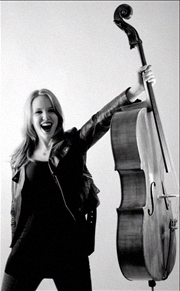Tutor HuntResources Cello Resources
Self-expression Vs Self-criticism
An exploration of the balance of self-expression and self-criticism in learning to play the Cello
Date : 31/01/2016
Author Information

Uploaded by : Hannah
Uploaded on : 31/01/2016
Subject : Cello
It is a widely known fact that playing and
listening to music can improve your mood. Studies on musician’s brains shows
that hearing a familiar piece of music lights up more different parts of the
brain that any other activity. Singing releases a high level of endorphins,
heightening the singer’s sense of enjoyment and happiness. When learning to play an instrument, this is the
most important thing to focus on: the positive effect of music on our emotions.
In the process of learning an instrument, however, this can be overshadowed by
the physical technicalities of playing. People who regularly listen to the
music of their chosen instrument tend to have high expectations of their own
playing aiming to replicate the sound made by their favourite artists. This
affects people in different ways – for example, music students are prone to
comparing their playing to their fellow students, demanding the highest level
from themselves, while adult beginners can easily become frustrated by the
difficulties of attaining the technical prowess needed to enjoy their own
playing. Music teachers have a vital role to play in this helping their pupils
to establish the technique necessary to achieve their aim. While this could be
seen as “anti-expression”, focusing on technique before music, without the
proper technical grounding no musician can have the facility to fully express
themselves. In this way, technique fuels expression and, ultimately, enjoyment of
music. The area of a Cellists’ technique which is vital
to enable the full range of expression is the posture of the body while
playing. This can easily be glossed over in favour of expressive techniques
such as vibrato and virtuosic playing, but if the body is not relaxed and
stable, then finding the physical freedom to change the sound expressively can
be very difficult. In my own musical education, and through teaching others, I
have found a number of key points which are easy to understand, and immediately
make playing more comfortable and satisfying. For example:·
Ensure
feet are always flat on the floor. This is the most
basic point, but always makes a noticeable difference in the tone and strength
of the sound: when both feet are grounded, there is a significant drop in the
amount of tension carried in the upper body, allowing both arms to feel more
free and produce a stronger, more centred sound. ·
The
upper body is always supported by the core.
Particularly with the cello, trying to produce a strong tone can easily bring unwanted
tension to the shoulders, upper back and neck. If, while sitting, the core
muscles in the abdomen and lower back are active, the shoulders do not need to
tense in order to make sound, and the arms can move more freely, consequently
with more expressive power. ·
The
left and right sides of the body work symmetrically.
Any tension in one side of the body is likely to be mirrored in, or even caused
by, the same area in the opposite side. Thumbs are a good example of this if
the left thumb is squeezing the neck of the cello, the right thumb is likely to
be gripping the bow too tightly. This can cause tension in the wrists, and restrict
the sonority of the sound. Focusing on releasing one thumb can automatically
loosen the other. ·
Arches
are key in the structure of each hand. The arch is the
strongest man-made structure self-supporting and able to bear loads far
heavier than the arch itself. This idea is very helpful in cello playing: each
finger of the left hand should be arched gently, allowing the weight of the arm
to sit on the string without any tension in the finger itself. This allows the
hand freedom to move and change positions easily, and prepares the way for a
relaxed, flexible range of vibrato. ·
Breathing
is crucial. Though this may sound obvious, it is
very easy to forget to breathe properly while focusing on a difficult technical
passage. A simple reminder to breathe slowly and deeply encourages all the
above points aiming for a relaxed, natural posture that allows a full range of
movement in the arms and hands, using the necessary strength in a positive,
expressive way. When tackling a new expressive device, such as
vibrato, it is vital to remember that it is just that – expressive! Trying to
master the physical movement can cause tension which limits the range of motion
in the arms, constricting the sound and making the movement much harder than it
needs to be. Teachers can help this by only focusing on a new technique for 5
minutes of the lesson, and reminding their pupils to practice it regularly but
only as part of a grounded practice session. Always coming back to the idea of a relaxed and
stable posture, through these 5 key points, will make the learning process much
easier on the pupils’ minds and bodies, and ensure that the focus is always on
expression and enjoyment!
This resource was uploaded by: Hannah
